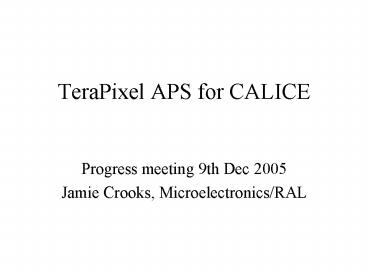TeraPixel APS for CALICE PowerPoint PPT Presentation
Title: TeraPixel APS for CALICE
1
TeraPixel APS for CALICE
- Progress meeting 9th Dec 2005
- Jamie Crooks, Microelectronics/RAL
2
Slide removed
3
SRAM vs DRAM
2.4um pitch
9.5
8.7
7.7
6.9
6.9
6.1
SRAM
DRAMs LONGER GATE
DRAMs CPOD CAP
DRAMs SIMPLE (OPIC)
4
DRAM lifetime simulations
Process corners Typical, worst-power (wp),
worst-speed (ws)
Applying negative off bias to reduce leakage
further
5
(Excel sheetpitch-size-noise-lifetime.xls)
6
Diode operation
- Pulsed Reset
- In-pixel self-reset circuit? More complex.
- Hard/soft reset
- Large output voltage range (1.7v)
- 210e threshold ? 9mV drop in diode voltage
- Continuous Reset
- Logarithmic response
- May take several us to reset
- Small output voltage range (200mV)
- 210e threshold ? 9mV drop in diode voltage
7
Diode reset characteristic
Wired Reset
Pulse height increases logarithmically with
electrons
100ns charge collection time
Exponential recovery characteristic (Reasonable
approximation with three Ae-ax terms)
Pulsed Reset
Pulse height increases linearly with electrons
Reset is applied
8
Simulations
9
Parametric plot
Log response continuous reset pixels Linear
response pulsed reset pixels
10
Comparator Types
- Voltage comparator, fixed threshold
- Clocked
- Continuous current
- Voltage comparator, moving threshold
- Clocked
- Differentiation comparator
- Continuous current
11
Voltage comparator Fixed Threshold
- Continuous (low current, asynchronous) or clocked
(current spikes) - Pixel/localised offset trim Programmed stored,
or possibly auto-calibrated between pulse trains? - As used in OPIC, but not suitable for CALICE
12
Voltage comparator Moving Threshold
- Clocked circuit (current spikes)
- Real-time pixel value is sampled each clock
cycle Vsample Vth gives local threshold for
comparison - Detects each hit once
- Immune to pixel reset rate
- Clocked design typically 2 clock signals
(sometimes more, or non-overlapping schemes
necessary)
13
Differentiating Comparator
- Continuous operation (asynchronous output)
- Capacitive coupling gives a current proportional
to rate-of-change of the voltage input - Detects each hit once (asynchronous duration of
charge collection is linear ramp an accurate
model?) - Immune to pixel reset rate
- (Needs circuit development)
14
Questions
- Take diode reset model and investigate
probability of pile-up - Assume wired-reset style pixel
- Is pile-up rate acceptable?
- Large signal
- Physics simulations ? electrons figures for a
50um pixel with 4 diodes - Max Min signals on individual diodes for 1 MIP
- Necessary threshold level for optimum crosstalk
- 4 diodes preferred from electronics view is
this enough for the physics? - Is my hit modelling reasonable?
15
Multiple diodes
- N diodes, analog signal addition
- Forked source-follower circuit ( 0.9 S )
- N diodes, Individual select
- Rotational selection wires 1 diode to pixel
comparator and logic - N parallel diodes, single collecting node
- StarTracker 25um pixels, 4 diodes, 15fF node
capacitance - Iimas 32um pixels, 2 diodes,
16
Summary / Design Choices
- Diodes Parallel / Analog-sum / Seq. select
- Pixel size 25um / 40um / 50um
- Number of Diodes 1 / 4 / more
- Reset Switched / Continuous
- Comparator Fixed threshold / Adaptive
threshold - Comparator Continuous / Clocked
- Memory SRAM / DRAM
- Variant SIMPLE / LONG / CPOD
17
REFERENCE Diode behaviour approximation
V0
dV
A 0.07 B 0.05 C 0.04 a5000000 b80000
0 c110000
100ns

